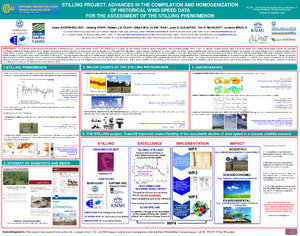Por favor, use este identificador para citar o enlazar este ítem:
http://hdl.handle.net/20.500.11765/11954
Stilling project: advances in the compilation and homogenization of historical wind speed data for the assessment of the stilling phenomenon
| Título : | Stilling project: advances in the compilation and homogenization of historical wind speed data for the assessment of the stilling phenomenon |
| Autor : | Azorín Molina, César; Chen, Deliang; Dunn, Robert J. H.; Klein Tank, Albert M.G.; Guijarro Pastor, José Antonio


|
| Palabras clave : | Wind speed; Atmospheric circulation; Stilling |
| Fecha de publicación : | 2018 |
| Citación : | EGU General Assembly (2018) |
| Versión del editor: | https://dx.doi.org/10.13140/RG.2.2.18006.34888 |
| Resumen : | During the last decade scientists have reported a terrestrial slowdown in wind speed across the world. This weakening in wind speed has been recently termed the “stilling” phenomenon, with a worldwide average trend of -0.140 m s-1 decade-1 reported since the 1960s. The precise causes of this “stilling” remain largely uncertain and have been hypothetically attributed to several factors, mainly related to an increase in surface roughness (i.e. forest growth, land use changes, and urbanization) with little attention paid to changes in atmospheric circulation. Unlike this “stilling” over land, satellite measurements have revealed that wind speed has increased over ocean surfaces, which introduces uncertainty to the “stilling” debate. Therefore, scientists are currently debating if global warming has and will impact on changes in wind speed.The uncertainty on the causes driving the “stilling” over land is mainly due to short availability (i.e. since the 1960s) and low quality of observed wind speed records as stated by the Fifth Assessment Report (AR5) of the Intergovernmental Panel on Climate Change (IPCC) and the recent report “State of the Climate in 2015” . The main objective of the ongoing EU funded project STILLING (MSCAIF-2015 GA-703733) is to fill the key gap of short availability and low quality of wind speed datasets, and improve the limited knowledge on the causes driving the “stilling” in a climate change scenario. This has not yet been addressed by the scientific community due to (i) scientists have traditionally paid little attention on variability of wind speed; (ii) digitization of climate series at National Weather Services (NWS) systematically started in the 1960s, however, some longer but isolated past wind speed records are available for scientists to be rescued and analyzed; and (iii) efforts on advances in homogenization algorithms to improve quality of wind speed series have been scarce. The STILLING project covers a novel research niche on the “stilling” debate, and this contribution will present the advances in the compilation and homogenization of historical wind speed data (prior to the 1960s) to better assess trends/cycles and causes on multidecadal time periods and reliable datasets than previous studies. |
| Descripción : | Póster presentado en: EGU General Assembly 2018 celebrada del 8 al 13 de abril en Viena, Austria. |
| Patrocinador: | This research has received funding from the European Union’s Horizon 2020 research and innovation programme under the Marie Skłodowska-Curie grant agreement No. 703733 (STILLING project). |
| URI : | http://hdl.handle.net/20.500.11765/11954 |
| Colecciones: | EGU General Assembly |
Ficheros en este ítem:
| Fichero | Descripción | Tamaño | Formato | ||
|---|---|---|---|---|---|
| Azorin_Molina_et_al_E... | 4,23 MB | Adobe PDF |  Visualizar/Abrir |
Los ítems de Arcimis están protegidos por una Licencia Creative Commons, salvo que se indique lo contrario.





